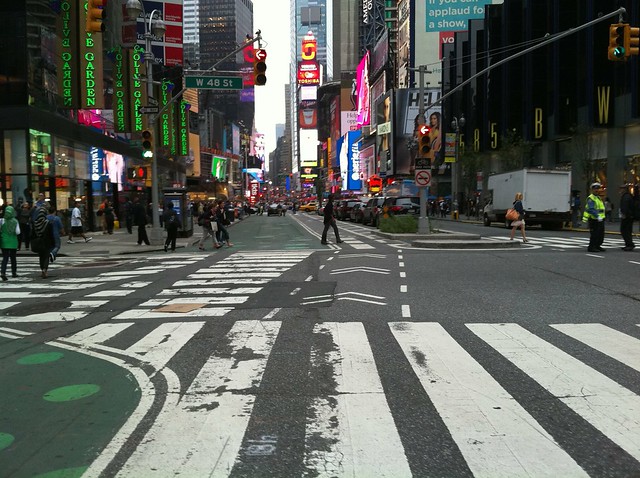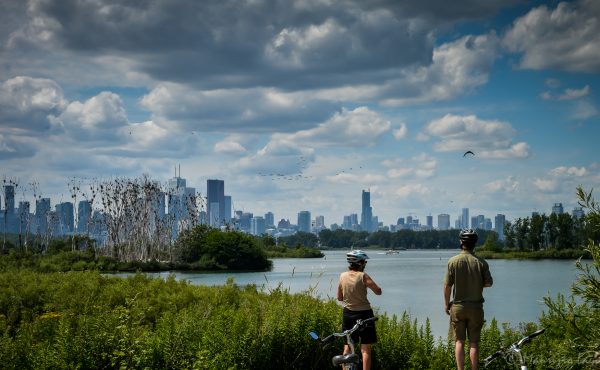
A press gallery silenced. A mayor building a reputation for being MIA. Councillor Minnan-Wong proposing forward thinking bike infrastructure on main streets.
Having moved to New York shortly before Rob Ford’s election, following Toronto politics from abroad has gone from the tragic to the downright bizarre, especially when it comes to the future of bike infrastructure. But good things never come easily, in Toronto or elsewhere.
In New York, a city quickly making a name for itself as North America’s future bike Mecca, opposition is mounting towards those bright green lanes, often fully separated from traffic on some of the city’s most congested, hallowed thoroughfares. Dubbed the “bike wars” by the local media, drivers and alternative transportation advocates are squaring off in what’s becoming an increasingly heated political battle.
Ring a bell?
It’s worth pointing out that the contexts are strikingly different between Toronto and New York City. After all, we’re not talking about the odd painted line or loss of a single car lane on Jarvis Street. Installing 250 miles of lanes in five years, as has been done in New York City, should cause a stir. With million-dollar-a-block treatments radically redesigning streets to make them more friendly for pedestrians and cyclists often at the expense of car lanes and parking, there’s a good argument that such drastic changes should go through greater public consultation processes.
Local community boards meetings — New York’s hyper-local arm of municipal government established as a way for communities to proactively participate in city issues — are fast becoming the forums for startled residents and local businesses to vent about the changes. And politicians are noticing.
Last November, Staten Island city councillors successfully fought for the removal of a 2.35 mile bike lane on a main street in their borough. Street protests have broken out over a single bike lane along Prospect Park West — a street bordering Brooklyn’s version of Central Park now surrounded by gentrified brownstones. Fights between bike-riding hipsters and Hasidic Jews over bike lanes in Williamsburg, Brooklyn are all too real. Just last week, the idea of licensing cyclists was raised by a Republican councillor in Queens.
Indeed, Republican city councillors are showing their increasing sophistication by arguing that bike lanes should have to go through a lengthy environmental review process that other traffic changes must endure. Such a move would essentially kill the currently expedited process allowing for lanes to be built all over the city at such a furious pace.
Luckily for New York City, anti-bike activists are still playing catch-up. For years now, the City’s Transportation Commissioner Janet Sadik-Kahn has openly questioned the place of the car on the city’s streets with the full backing of Mayor Bloomberg. Combine this with a strong mayoral system and Transportation Alternatives, the city’s sustainable transportation advocacy group that organizes large pro-bike rallies, fills community board meetings with vocal supporters and overwhelms unfriendly politicians’ office inboxes with floods of e-faxes seemingly at will, and those Staten Island politicians still have a long way to go.
These huge successes aside, I’d still prefer riding my bike in Toronto any day. Green painted lanes buffered from traffic with their own signal lights are nice and all, but they’re still relatively lonely places — ignoring the jaywalkers — that lack crucial connections through particularly hairy parts of the city like midtown Manhattan. Riding in mixed traffic is great if you’re looking for the occasional thrill of cars and cabs giving you absolutely no room or respect, but not if you’re looking for a safe and stress-free commute home. Sidewalk parking is virtually non-existent, bikes are prohibited on buses and a huge challenge to take on the subway, and a kryptonite lock means nothing if you decide to leave your bike outside at night.
That is to say, Toronto isn’t alone in its struggle to become more multi-modal. Too often, bike success stories from abroad only make it to our fair city once the battle has already been won. Left out of the picture are the all too similar struggles it took each city to get there.
Sure New York City has come a long way, but that’s partly because of how far it has to go. But if they continue to expand its bike infrastructure at this pace, I have every confidence New York City will surpass Toronto in terms of bikeability.
But until then, I’d rather ride on College Street.
photo by Jake Schabas




6 comments
Jake is not wrong – the bike wars here are real, and though people like me like to shove pretty pictures of Manhattan bike lanes in the noses of Torontonians to taunt them there is a lot of background struggle that we don’t always report on.
Often, the situation is very similar to St. Clair. Local merchants complain about the loss of a couple parking spots and blame the non-car mode of transit that has taken over a chunk of their street. The fact that few people probably drive to a corner deli, or even if they do whether the wishes of a dozen businesses should outweigh the quality of life of tens of thousands, rarely is noticed. Small businesses exist, public meetings exist, and the two combined result in great theatre.
The difference between Toronto and New York is that the government here is very sophisticated and tends to win out with smart, reasoned thinking. In Toronto, situations like the above spin out of control, with lots of finger pointing and weak politicians bending to the squeakiest voice, policy be damned. In New York, Bloomberg has been around long enough to have trained every department to deal in data. You say the new bike lane is slowing traffic? Ok, we’ll put GPS in the entire taxi fleet and monitor traffic speeds for a year and see if you are right or not. Not enough parking spaces? Ok, we’ll do a turn-signal study and see if we can take some turning lanes out and turn them back into parking. Outer-borough whining about a suburban bike lane? Ok, we’ll replace it with a bus lane to see how that works and preserve the idea of giving street space to other modes than private cars. It’s quite something to see the NYC govt manage such a hot item in such a chaotic city so effectively. The venting in the articles Jake links to are just part of the march of process.
Jake may be right that at the moment Toronto is still more hospitable to cyclists, ironically, because of the lack of infrastructure that forces cars and bikes to share space and get used to each other. It is indeed still a death wish to ride in mixed traffic on a major NYC street due to the lack of lane use in this town (the paint on the ground is meaningless – traffic “flows” down those big avenues in a way that cannot be described as following lanes). But for recreational biking New York cannot be beat — just look at the bike map (http://www.nyc.gov/html/dot/html/bicyclists/bikemaps.shtml). You can plan trips hours-long and never have to deal with cars – the connectivity is amazing. As as for parking, NYC is catching up fast. Anyone can request a rack (http://www.nyc.gov/html/dot/html/bicyclists/bikerack.shtml) and laws here now require parking inside office buildings (http://www.nyc.gov/html/dot/html/bicyclists/bikesinbuildings.shtml). Keep your eye on the Big Apple…
Thanks for the article.
Vancouver is experiencing a similar “backlash” against the separated bike lanes that were installed in the past few months, with the focus of anger mainly (I believe) situated on the Hornby lane. From what I can gather from my perch over here in Toronto, a lot of the dissatisfaction stems from a perception that the City moved too fast on the issue and that public consultation was just for show as minds had already been made up. The fact that construction started the day after council approved the bike lane probably didn’t help that perception.
These kinds of infrastructural changes are always a delicate balancing act, especially when they centre around such (unfortunately) heated and contentious issues as bike lanes.
I disagree that the “bike backlash” is either a real democratic movement or deserves to halt the progress toward making more bike lanes.
I think the backlash is more imagined than real. CBS2 has been covering this non-issue for months and the New York Post seems to take joy in revving up anti-bike anger. At the end of the day, let’s remember that the majority of New Yorkers don’t own cars and spend most of their time getting around by rail not by road – so why would they care about bike lanes?
“Sidewalk parking is virtually non-existent.” I disagree:
http://www.nyc.gov/html/dot/html/bicyclists/bicycleparking.shtml
As for the choice of College Street over New York streets, I would personally take New York over negotiating the area between moving traffic, swinging car doors, and streetcar tracks on College.
A suggested counter-point to this piece would be a write-up about the Hudson River Greenway: http://en.wikipedia.org/wiki/Manhattan_Waterfront_Greenway. This is possibly the best (and most popular) piece of bike infrastructure on the continent. (Apologies to the Martin Goodman Trail.)
…meanwhile, without any war on cars or on bikes and certainly not much media attention, Montréal has quietly built around 500km of bike paths on the island, with more in the suburbs, too. They even keep the main paths leading to downtown free of snow during the winter for bikes (and wheelchairs, as it happens). Even the Bixi bike sharing program, which eats up quite a few more parking spots from spring to late fall, is praised much more than it is condemned. See http://pistescyclables.ca/Montreal/Montreal.htm for some maps and pictures.
Josef, there is some anti-bike feeling among pedestrians but New York has been clever enough to usually include pedestrian enhancements along with new bike lanes, thereby guaranteeing overall pedestrian support. (This is something that Toronto infamously failed to do with Jarvis, where bike lanes were created but angry pedestrians lost their promised wider sidewalks and landscaping.)
Do note though that while few Manhattanites own cars most outer-borough residents do have access to a car or use one on occasion. Like in Etobicoke, Scarborough, etc. they have a permanent chip on their shoulder about supposed downtown-elite favouritism and consider every anti-car move an affront to their ability to hang on to a middle- or working- class life in the big city. This rears its head most often during discussions about bridge tolling (which any sane person would think would be nothing but beneficial to New York overall) but it comes out during bike lane discussions also.
That said, you are correct that as in Toronto, New York has many newspapers and other media who have pages to fill and nothing beats drumming up the opposing view. The city administration is certainly not backing down on their overall vision.
I have to say that the protected bike lanes in NYC are incredible compared to striped bike-lanes, which simply become double-parking lanes. The smaller streets and fewer people in Toronto certainly go a long way to making it feel more comfortable to ride a bike there, but the strides NYC is making are pretty incredible. People like to cite the 250 miles of striped bike lanes figure, but I think the 13 miles of protected bike lanes since 2007 are far more important, but have also been far more controversial. As for connectivity, many community boards are starting to demand protected bike lanes in their neighborhoods and for connections to be completed in the network. The 2012 bike-share in NYC will include 10,000 bikes at 600 stations, whereas Toronto will have 1,000 bikes at 80 stations.
The point is, New York is very quickly becoming a bike-friendly place. The backlash people must sense this, and are trying to nip it in the bud. Fortunately for cities, this is a worldwide movement with the support of all sorts of discipline at all levels of government.